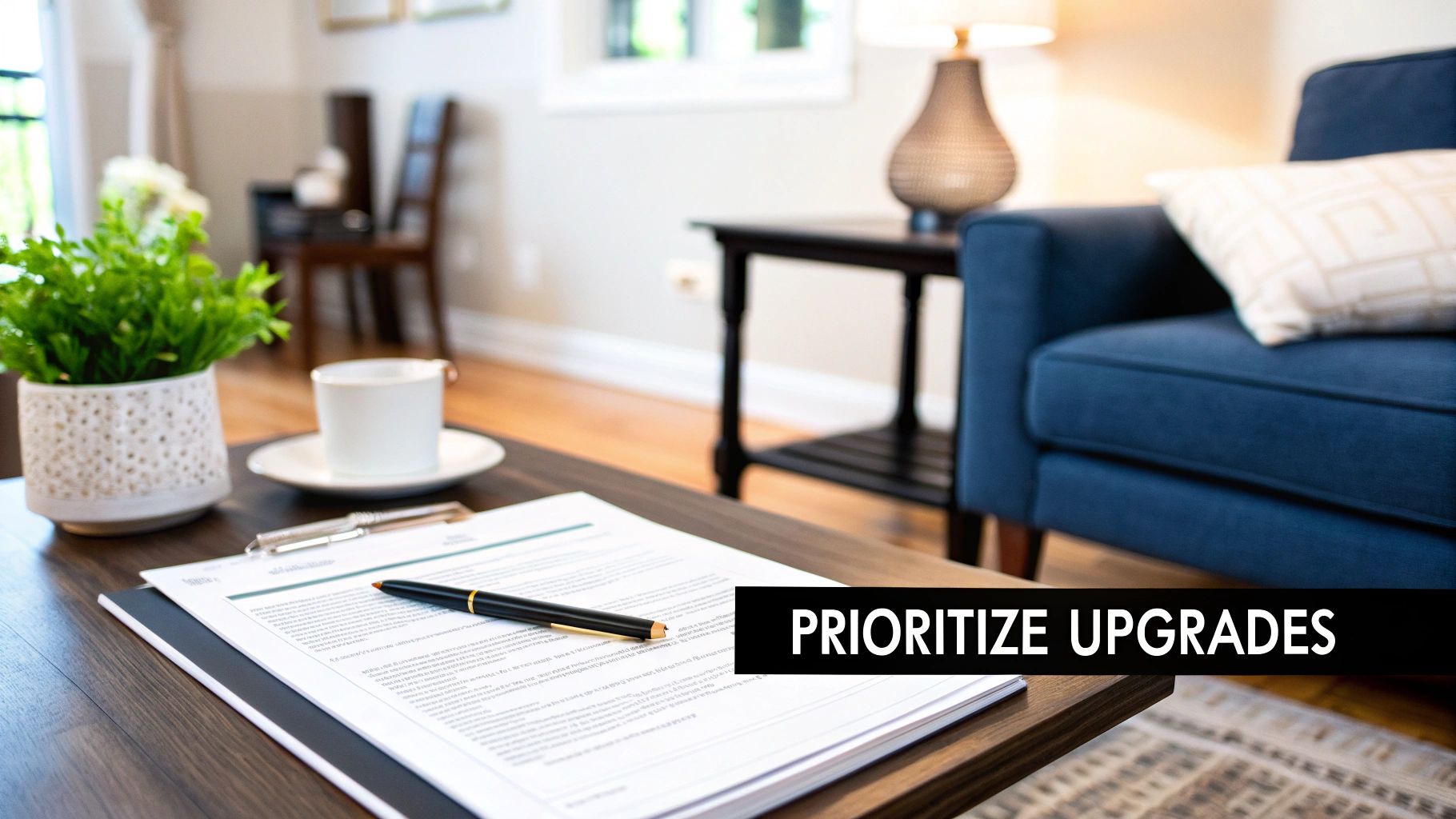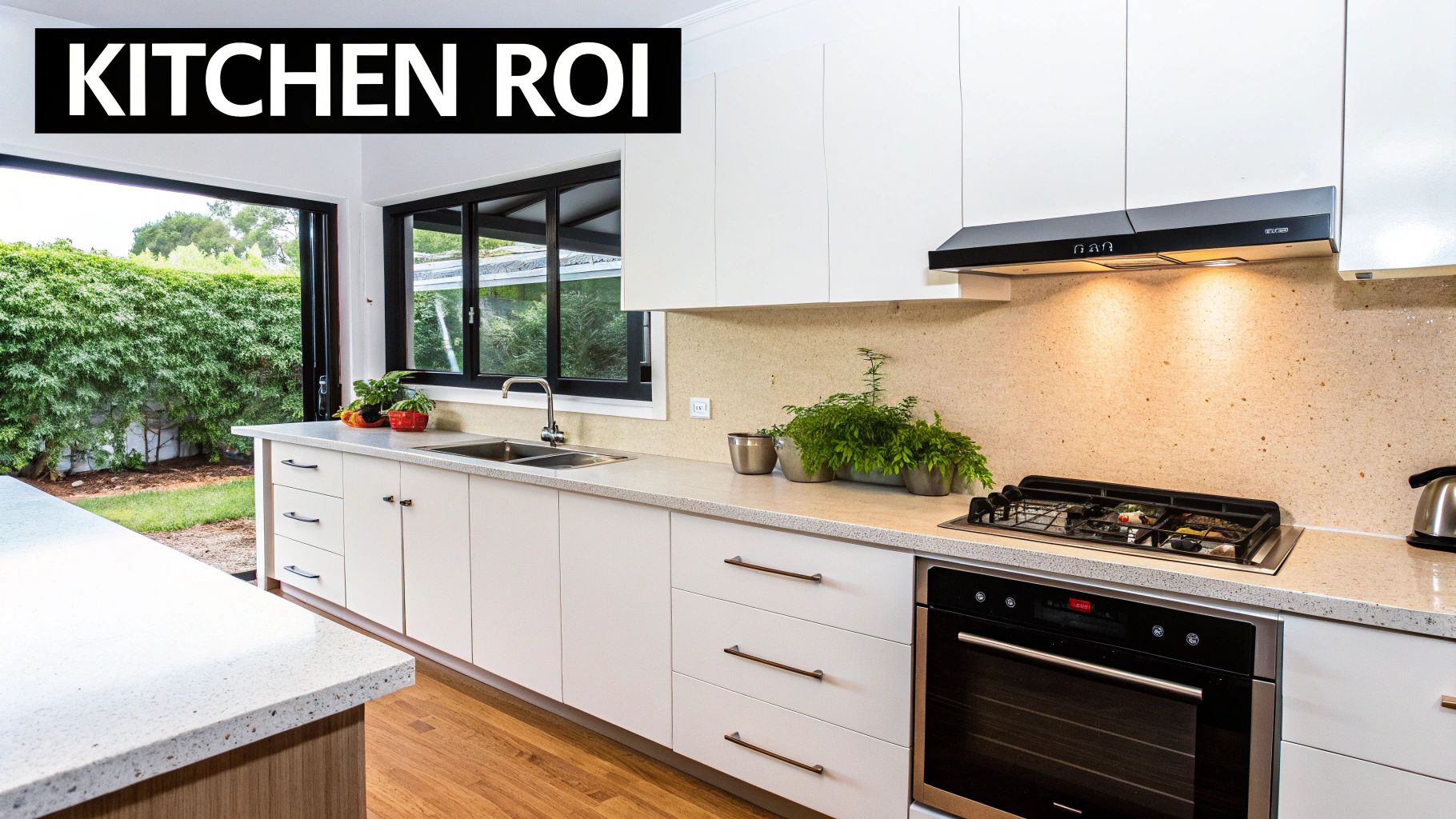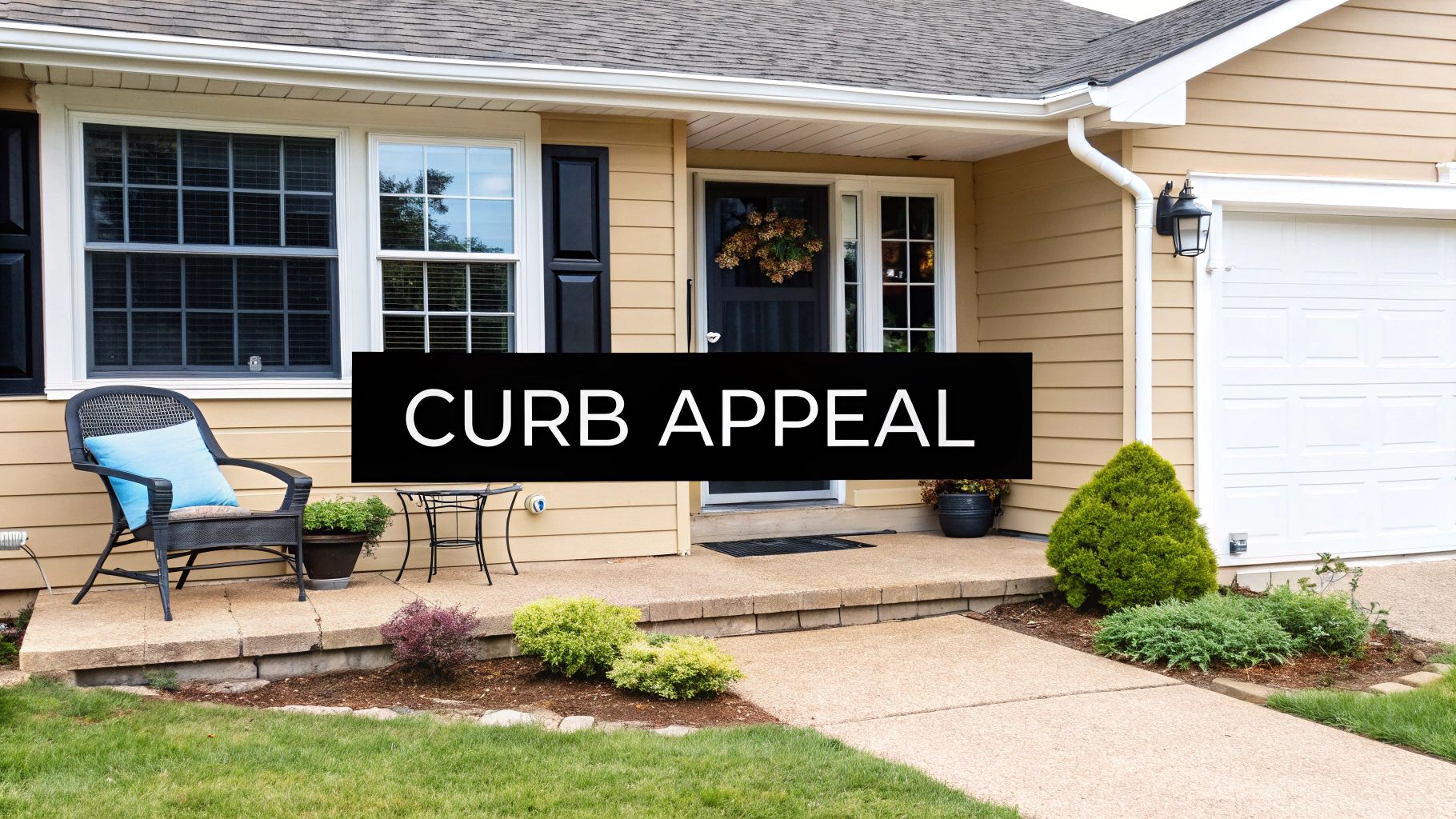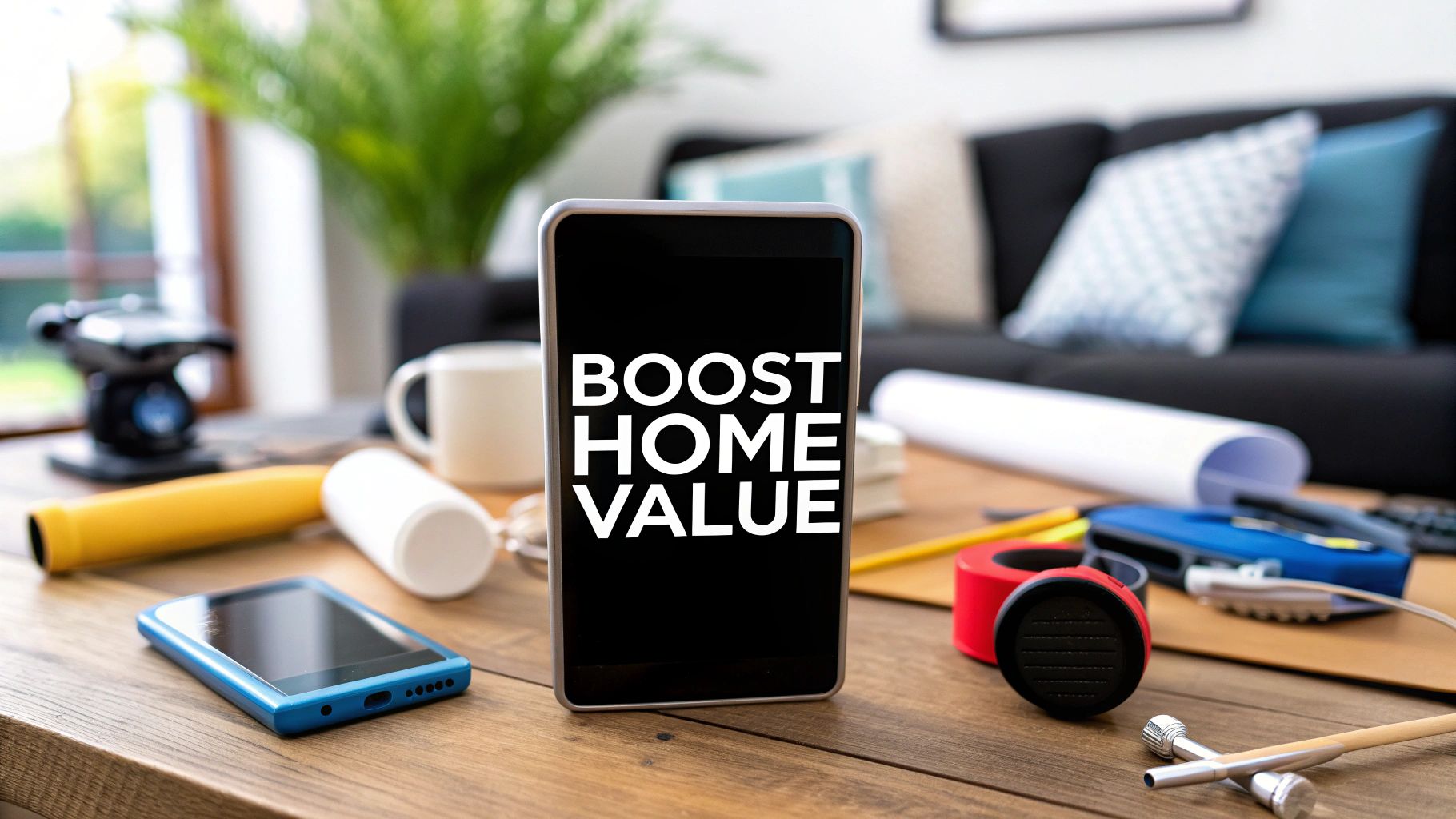If you're looking to increase your property's value, the secret isn't just about spending money—it's about making smart, targeted investments that today's buyers are looking for. The best strategy always combines a few cosmetic touch-ups, functional upgrades where they count most (like kitchens and bathrooms), and a solid commitment to ongoing maintenance.
When you prioritize projects that nail the first impression and enhance the core living areas, you're putting your money where it will deliver the biggest bang for your buck.
Laying the Groundwork for a More Valuable Home
Before you even think about picking out paint colors or new fixtures, you need to start thinking like a property appraiser. The goal here isn't just to make your home prettier; it's about making deliberate upgrades that directly translate to a higher market value. It's a delicate dance between your upfront cost and the return you'll see when it's time to sell.
What buyers want changes over time. That trendy kitchen remodel from five years ago might fall flat with today's buyers, who are often more interested in energy efficiency or smart home capabilities. Thinking strategically from the get-go keeps you from pouring cash into projects that won't move the needle. A great starting point is to walk through your own property with a critical eye, looking for anything that feels dated or just doesn't function well anymore.
Prioritizing Your Projects
Let's be clear: not all home improvements are created equal. You need to focus on the projects that tackle the fundamental elements of what makes a home truly desirable. These usually fall into a few key buckets:
- Key Living Spaces: Kitchens and bathrooms almost always deliver the highest returns. They are the heart of the home, and buyers notice them immediately.
- First Impressions: Curb appeal is everything. What a buyer sees from the street—from the landscaping to the front door—sets the stage for their entire viewing.
- Structural Integrity: A new roof or updated HVAC system might not be glamorous, but they offer incredible peace of mind and are a huge selling point.
- Ongoing Upkeep: Never underestimate the power of consistent maintenance. Fixing small issues before they become big, expensive problems is a core part of protecting your property's value. You can find ways to simplify this by checking out our guide to property maintenance management software.
This infographic breaks down some of the most reliable upgrades for boosting your home's value.

As you can see, channeling your budget toward the kitchen, bathroom, and exterior is a proven path to adding real, measurable worth to your property.
To help you decide where to start, here's a quick look at some of the most impactful upgrades.
High-Impact Upgrades at a Glance
| Improvement Area | Typical ROI | Best For |
|---|---|---|
| Kitchen Remodel (Minor) | 70-80% | Homes with dated but functional kitchens. |
| Bathroom Remodel | 60-70% | Properties with worn-out fixtures or poor layouts. |
| Exterior Paint & Siding | 75-85% | Maximizing curb appeal for a strong first impression. |
| Landscaping & Deck | 50-100% | Enhancing outdoor living space and buyer appeal. |
| New Windows (Energy-Efficient) | 65-75% | Older homes needing an efficiency and aesthetic boost. |
This table reinforces that focusing on high-visibility areas that improve daily life or curb appeal is almost always your best bet.
Expert Tip: One of the biggest mistakes I see homeowners make is over-personalizing their space. While you should absolutely love your home, if your main goal is to increase its value for a sale, stick with neutral colors and timeless finishes. You want to appeal to the widest possible audience, not just your own specific taste.
Focusing Renovations Where They Count Most
If you want to increase your property's value, you have to be smart about where you put your money. Not all renovations are a good investment, and I’ve seen countless owners overspend in the wrong areas.
Time and again, two rooms consistently deliver the biggest bang for your buck: the kitchen and the bathrooms. These are the functional and emotional heart of a home, and they're the first places potential buyers look. A great kitchen can sell a house on its own.
An outdated kitchen is more than just an eyesore; it's a major red flag for buyers. They see dollar signs and a huge headache. But a fresh, modern kitchen? That's where they picture themselves making breakfast, hosting holidays, and living their lives.

Modernizing the Kitchen for Maximum ROI
So, what are today’s buyers looking for? It’s a mix of clean aesthetics, long-lasting materials, and efficiency. You don't have to tear everything down to the studs to achieve this.
Here’s where to focus your budget:
- Countertops and Cabinets: Get rid of those dated laminate countertops. Swapping them for durable quartz or even a good-quality granite instantly lifts the entire room. If new cabinets aren't in the budget, don't worry. A professional paint job, new hardware, and maybe some new doors can work wonders.
- Appliances: Nothing screams "neglected" like a collection of mismatched, old appliances. A matching set of energy-efficient, stainless steel appliances is a must. It not only looks great but also signals lower utility bills to a savvy buyer.
- Fixtures and Lighting: These are the small details that make a huge impact. A new gooseneck faucet, a stylish backsplash, and modern lighting—like under-cabinet LED strips—can completely change the room's vibe for a relatively small investment.
The numbers don't lie. A smart kitchen renovation is one of the safest bets in real estate. We've seen properties with major kitchen upgrades get an average value bump of 10-15%. In a healthy market, you can realistically expect to recoup 70-80% of what you spend when you sell.
Here's a pro tip: You often get a higher percentage return on a minor kitchen remodel. Focus on high-impact cosmetic updates like paint, hardware, and fixtures before committing to a six-figure overhaul.
Creating a Bathroom That Sells
Right behind the kitchen, the bathroom is a make-or-break space. Buyers are looking for a personal retreat—a space that feels clean, modern, and relaxing. A grimy, cramped bathroom can kill a deal fast.
To truly maximize your property's value, focus your efforts on the best return on investment for your home by concentrating on upgrades that really move the needle.
In the bathroom, that means hitting a few key points. Start with a modern vanity that offers good storage, a new toilet, and updated fixtures. If the tile grout is dingy, get it professionally cleaned or re-grouted. Ripping out old vinyl flooring and putting in a classic, water-resistant tile adds immediate and lasting value.
Finally, don't underestimate lighting. A new fixture and a large, clean-lined mirror can make even a small bathroom feel brighter and more spacious, leaving a great impression without breaking the bank.
Integrating Smart Tech That Adds Real Value
In a world where everything is connected, a property’s tech stack isn't just a bonus feature anymore—it's a fundamental part of its value. Potential buyers and renters, particularly in the multi-family and commercial spaces, have come to expect modern conveniences that fit their digital lives. A building that can't support seamless remote work or offer automated living feels dated right out of the gate.
The right technology upgrades are a fantastic way to boost your asset’s worth, but the trick is to focus on additions that provide real, tangible benefits. Forget the flashy gimmicks. We're talking about practical, high-impact solutions that genuinely improve security, convenience, and efficiency.

Foundational Tech for Modern Properties
Before you even think about advanced automation, you have to get the basics right. A property with spotty Wi-Fi or an ancient security panel is already starting from a major disadvantage.
I always tell clients to start with these two non-negotiables:
- Robust Network Infrastructure: High-speed, reliable internet is the new utility. For multi-unit or commercial buildings, a managed Wi-Fi solution is the gold standard. It guarantees strong, consistent connectivity for every single tenant, which is a massive selling point for today's remote workers and businesses.
- Smart Access and Security: Think video doorbells, smart locks, and centrally monitored security cameras. These systems provide both peace of mind for tenants and incredible operational efficiency for you. Tenants love being able to grant access to a dog walker or delivery person from their phone, and property managers get much better oversight.
Nailing these foundational elements creates a secure, connected environment. It's the perfect stage for the more advanced features that will really make your property pop.
Smart home technology is quickly becoming a standard expectation, not a luxury. A recent study found that 86% of millennials are willing to pay more for a rental equipped with smart home features. That’s a clear signal from the market about where demand is heading.
High-Impact Automation and Conveniences
With that solid core infrastructure in place, you can start layering in the automation features that truly boost appeal and allow you to command higher rents or sale prices. The best part? These technologies often pay for themselves through energy savings and happier, long-term tenants.
Look into systems that offer clear, demonstrable value:
- Smart Thermostats: These little devices are a win-win. They can slash heating and cooling costs by up to 15%—a seriously compelling benefit for any buyer or tenant. Plus, they learn preferences and can be controlled from anywhere, adding that modern convenience people crave.
- Automated Lighting: App-controlled and motion-sensor lighting is a relatively low-cost upgrade that makes a huge difference. It immediately makes a property feel more modern and responsive while enhancing both security and energy efficiency.
- Integrated Property Management: For multi-family buildings, pulling all this tech into a single, cohesive platform is the real game-changer. You can dive deeper into this by exploring our ultimate guide to smart apartment technology, which breaks down how an integrated system can simplify operations for everyone.
By strategically layering these technologies, you’re not just adding gadgets; you're building an intelligent, efficient, and highly desirable property. It’s a powerful move that shows you understand modern demands, making it a cornerstone strategy for anyone serious about increasing property value in today’s market.
Boosting Your Bottom Line with Energy Efficiency
Energy efficiency used to be a "nice-to-have" feature, but now it’s a core expectation. Let's be honest: today's buyers and tenants are savvy. They’re looking at rising utility costs and actively hunting for properties that won't drain their bank accounts every month.
Making smart, energy-saving upgrades is one of the most direct ways to meet this demand and pump up your property’s value. This isn't just about environmental brownie points; it's a solid financial play. These improvements don't just add to your asset's long-term marketability—they often start paying for themselves from day one through lower operating costs.
Pinpointing Where to Invest for the Biggest Impact
Before you start tearing down walls or writing checks, get a professional home energy audit. Think of it as a diagnostic report for your property. It’ll tell you exactly where you're bleeding energy—is it drafty old windows, a poorly insulated attic, or an ancient HVAC unit? This data is gold because it helps you put your money where it will actually make a difference.
Once you know your weak spots, you can focus on the upgrades that deliver the most bang for your buck. In my experience, these are the heavy hitters:
- Beef Up the Insulation: This is rarely glamorous, but it’s often the most cost-effective move you can make. Adding or improving insulation in the attic, walls, and crawl spaces keeps the indoor temperature stable, which means your heating and cooling systems don't have to work nearly as hard.
- Upgrade Your Windows: If you have old, single-pane windows, you're essentially throwing money outside. Swapping them for modern double- or triple-pane windows with low-E coatings can cut energy bills by 10-25% a year. Plus, they do a much better job of blocking outside noise.
- Switch to Energy-Saving Appliances: When a potential buyer or tenant sees an ENERGY STAR label on the refrigerator, dishwasher, or water heater, it sends a powerful message. It says the property is modern, efficient, and well-maintained.
These aren't just line items on a feature sheet. They create a home that's genuinely more comfortable and affordable to live in, and that’s a combination that always sells.
The "green premium" is very real. I’ve seen it time and again. Homes with certified energy-efficient features don't just sell faster; they consistently command higher prices than comparable properties down the street. It’s a clear signal of the market's shift toward long-term value.
The Financial Case for Going Green
Investing in energy efficiency is a direct strategy for how to increase property value. As sustainability becomes a bigger part of the conversation, these features are becoming a major selling point.
Recent data shows that homes with solar panels, high-performance windows, and smart thermostats can fetch a premium of 5-10% over similar properties. A great example comes from Germany, where homes with a top-tier A+ energy rating sold for an average of 8% more than those with lower ratings. For a deeper dive into these global trends, check out the analysis from UBS Asset Management.
You can take these improvements a step further by layering in smart technology. For instance, a building automation system can centralize control over lighting, heating, and cooling, which not only maximizes savings but adds a level of modern convenience that sophisticated buyers are absolutely willing to pay for.
Maximizing Curb Appeal and Outdoor Spaces
That first impression is everything. The second a potential buyer or tenant pulls up to your building, they're already forming an opinion and, whether they realize it or not, starting their own personal valuation. Great curb appeal isn't just about a neat lawn; it's the opening statement for the entire property. It sets a positive, high-quality tone before they even step inside.
You don't need a massive budget to make a big difference, either. A fresh coat of paint on the front door, some stylish new house numbers, or updated exterior lighting can be weekend projects, but they pack a serious punch. These small touches add up, creating a polished look that tells people you care about the details.
Creating Inviting Outdoor Living Areas
These days, a deck or patio is so much more than a slab of concrete out back. Buyers and renters see these spaces as a true extension of their living area, and they're willing to pay a premium for it. Your goal should be to make the outdoors feel like a seamless part of the home.
Here's how you can make that happen:
- Define the Space: An outdoor rug can anchor a seating area, while distinct furniture groupings can create zones for dining and relaxing.
- Bring in the Green: Container gardens and well-kept flower beds add a pop of color and life, softening hardscapes like wood or stone.
- Build in Privacy: Thoughtfully placed fencing, a trellis with climbing vines, or a row of tall hedges can turn an exposed yard into a private oasis.
When a potential buyer walks onto a beautifully staged patio, they don't just see furniture. They see themselves hosting a barbecue with friends or enjoying a quiet morning coffee. That emotional connection is what turns a casual looker into a serious buyer.
It’s not just about the movable stuff, though. Permanent, high-quality fixtures make a huge impact on value. Learning how a proper stone wall sets the property's value is a great example of how solid, well-crafted structures can be a massive long-term asset.
The Broader Impact of Location and Neighborhood
Of course, you can't pick up your property and move it, but its location is a massive piece of the value puzzle. Things happening in your neighborhood—new cafes, better parks, improved transit—create a halo effect that can seriously lift your property's worth without you lifting a finger.
Walkability is a perfect example. In major urban centers, being close to public transit is a game-changer. A recent Knight Frank Index showed that homes within a 10-minute walk of a train or metro station in cities like Paris and Toronto saw prices jump by 12-18% compared to similar properties farther out. You can learn more about how housing markets are evolving to stay on top of these trends. While you can't change your address, knowing and highlighting these local perks is a crucial part of showing off your property's full value.
Common Questions on Increasing Property Value

Diving into home improvements can feel like a minefield. With so many options, it's easy to wonder where to put your money for the best possible return. To help you make smart, confident choices, I've answered some of the questions I hear most often from property owners.
These are the practical, real-world answers that cut through the noise and reinforce the strategies we’ve been talking about. Think of it as your go-to reference before you start your next project.
Which Single Renovation Offers the Best ROI?
Year after year, one project consistently comes out on top: the minor kitchen remodel. It's not the full-blown, wall-smashing renovation you see on TV. Instead, it’s a strategic cosmetic refresh that regularly recoups over 80% of its cost when you sell.
The secret is to focus on high-impact updates that don't involve changing the kitchen's footprint. We're talking about things like:
- Refacing or professionally painting your existing cabinets.
- Swapping out old laminate for a modern quartz countertop.
- Installing a new sink, faucet, and a clean, stylish backsplash.
- Upgrading to a matching set of energy-efficient appliances.
This approach gives the heart of the home a major facelift, making it incredibly appealing to buyers without the staggering cost of a gut job.
How Much Value Does Adding a Bathroom Add?
This is a big one. Adding a bathroom can seriously move the needle on your property's value, often by 10% to 20%. The biggest leap in value happens when you take a one-bathroom house and add a second full bath.
But even a smaller addition packs a punch. A well-placed half-bath (or powder room) can boost value by 10-15%. The key here is strategic placement. An ensuite off the primary bedroom or a convenient half-bath on the main living floor adds a level of functionality that buyers notice immediately.
The real value isn't just in the fixture count; it's about improving the home's functionality. A well-placed bathroom solves a practical problem for future owners, and that's something they are always willing to pay for.
Are Expensive Landscaping Projects Worth It?
They can be, but you don't need a five-figure budget. Great curb appeal can tack on up to 10% to a home's perceived value, and you can get there by focusing on the fundamentals. Strategy beats a huge budget every time.
For the best return on your landscaping dollar, stick to the basics:
- A healthy, green lawn: This is the canvas for everything else.
- Well-defined garden beds: Fresh mulch and low-maintenance plants create a clean, intentional look.
- Mature trees: If you're lucky enough to have them, they're a massive asset. Keep them healthy and well-pruned.
- An inviting walkway: Make sure it’s clean, free of cracks, and well-lit.
High-end features like elaborate water fountains or outdoor kitchens have a much more unpredictable ROI and are usually only a good bet in luxury markets. For most properties, a clean, attractive, and well-maintained landscape is the most profitable path.
Should I Hire Professionals for All My Projects?
Absolutely not. There are plenty of DIY-friendly projects that can save you a bundle while still boosting your home's appeal. Think interior painting, updating light fixtures, swapping out cabinet hardware, or basic landscaping—these are all great places to start.
That said, some jobs are strictly for the pros. Anything involving electrical wiring, plumbing, or structural changes is non-negotiable. Trying to tackle these yourself can not only tank your property's value but also create serious safety hazards and lead to far costlier repairs down the road. It's just not worth the risk.
At Clouddle Inc, we specialize in the foundational technology that makes properties more secure, efficient, and valuable. From robust networking to integrated security, we provide the managed solutions that modern buyers and tenants demand. Learn more at https://www.clouddle.com.


